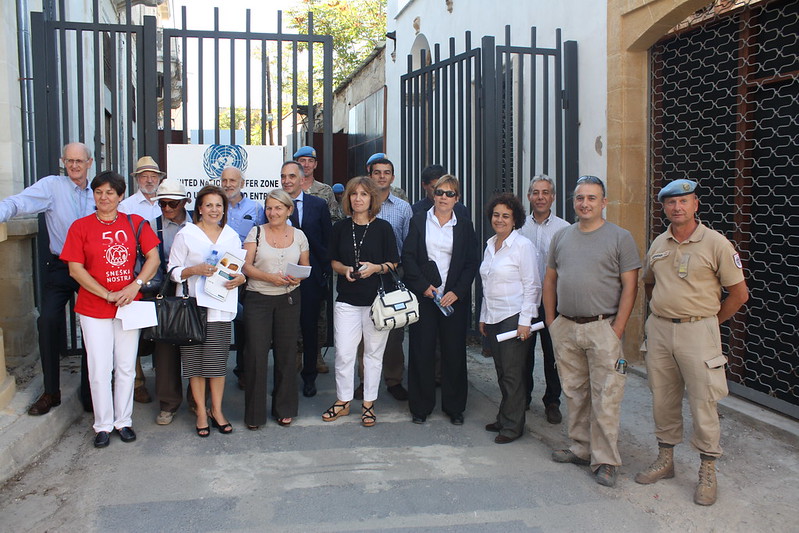Europa Nostra and EIB Institute Mission visits the buffer zone of Nicosia
For the first time in two years, representatives from European institutions and delegates from the Greek Cypriot and Turkish Cypriot communities visited the buffer zone of Nicosia, listed as one of The 7 Most Endangered Monuments and Sites in Europe, on 14-15 October. The mission covered the 1.5km corridor that divides the historic city centre escorted by civil affairs officers from the United Nations. The heritage and financial experts from Europa Nostra and the European Investment Bank (EIB) Institute also participated in working meetings with local and international entities to discuss the rehabilitation and redevelopment strategies for this heritage site.

The Cyprus dispute saw the creation of the Nicosia buffer zone in 1964 and its extension in 1974. This area cuts through the historic centre, dividing physically and socially the two communities who live in the city, the Greek Cypriots and Turkish Cypriots. Decades of abandonment have undermined the high architectural value of the buildings, among which are Medieval and Neoclassical monuments, and had a devastating impact on the quality of the environment and living conditions of the entire city. Once the focal point of crafts and trade, the centre of Nicosia is today a lifeless 1.5 km corridor.
Since the 1980s, the two communities have worked together, with the support of the United Nations, to produce a Master Plan for the revitalisation of the whole city and in particular the buffer zone which runs across its historic center. International assistance is today needed to start its implementation and restore, one by one, the historic buildings in this strip of land which can potentially act as a catalyst for the reunification of Nicosia.
On 14 October, the delegation of Europa Nostra – represented by its Executive Vice-president John Sell, its Vice-president Costa Carras, its Scientific Council Member Gianni Perbellini, and its Secretary General, Sneška Quaedvlieg-Mihailović – and the EIB Institute – represented by Peter Bond –, visited the buffer zone of Nicosia, the only divided city in Europe, accompanied by delegates of the two communities.
“This visit has allowed us to have an in-depth understanding of the historical and architectural importance of the site, as well as to witness the advanced state of decay of the buildings, many of which are in urgent need of being rescued,” stated John Sell.
“The buffer zone’s perimeter is about one fifth of the entire historic city of Nicosia and represents a real estate of huge value which has been frozen for almost four decades,” added Gianni Perbellini.
“For ten centuries, this was the most vibrant commercial area of the city. Many daily life activities took place here, bringing together all communities. But for the last 39 years, this area has been completely closed to the people. There is only one crossing at the heart of the city, which was opened in 2008, and a special permission granted by the UN is needed to access the buffer zone itself. The rehabilitation of the buffer zone would bring back cultural and social life to this area and thus strengthen the ties between the two communities”, stated Agni Petridou and Ali Guralp, Team Leaders of the Bi-communal Nicosia Master Plan (NMP).
Europa Nostra’s Executive Vice-President praised the work undertaken by the Greek Cypriot and Turkish Cypriot communities of Nicosia and highlighted the commitment of their representatives, Constantinos Yiorkadjis and Kadri Fellahoğlu, to implement the city’s Master Plan. Awarded a European Union Prize for Cultural Heritage/Europa Nostra Awards in 2011 for the Study of the Survey of the buffer zone, this Master Plan is a brilliant example of cultural heritage acting as a catalyst for peace, dialogue and reconciliation.
Prior to the visit, the heritage and financial experts took part in a round table discussion about the rehabilitation and redevelopment strategies for the Nicosia buffer zone. This initiative was organised by the EEA and Norway Grants. Androulla Vassiliou, European Commissioner for Education, Culture, Multilingualism and Youth, Sjur Larsen, Ambassador of Norway to Cyprus, and the delegates of the Greek Cypriot and Turkish Cypriot communities were among the keynote speakers. Takis Hadjidemetriou, on behalf of the Bi-communal Technical Committee on Cultural Heritage, Christopher Louise, UNDP-ACT Programme Manager, Tiziana Zennaro, UNDP-PFF Programme Manager, and Sheamus Cassidy, Senior Sector Officer Cultural Heritage and Diversity from the EEA and Norway Grants also added their valuable contributions to the discussion. “Reinforce cooperation” and “take action” were the main messages conveyed. Members of the Bi-communal NMP team and representatives from PRIO and Home for Cooperation also attended the gathering.
The delegation of Europa Nostra and the EIB Institute participated in four meetings with local, European and international stakeholders. The background studies which have been carried out for the area were presented by the team leaders of the Nicosia Master Plan, namely Athina Papadopoulou, Cemal Bensel, Simos Droussiotis, Zeka Yilmaz and Dinos Loigidis. The mechanisms of intervention available, as well as the preparation of a technical and financial assessment of short, medium and long-term actions, also dominated the agenda.
“The proposals presented by the NMP team in their Europa Nostra submission have been discussed during the mission and are currently being refined to provide a coherent and balanced programme of short, medium and long-term activities to prevent further deterioration and to prepare a relevant future for the zone. The works are likely to range from urgent propping works to prevent buildings collapsing to the renovation of some significant buildings, perhaps associated with new crossing points. A cost of about five million euros is indicated for this phase of works. Once the technical content is defined more clearly, the key issues of approvals and finance will need to be addressed. Further details will be available in early December,” stated Peter Bond, representative from the EIB Institute.
The results of the rescue mission to Nicosia will be presented, together with the outcomes of the six other missions, at the European Heritage Policy Conference, organised by Europa Nostra, in Brussels on 5 December.






